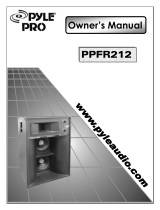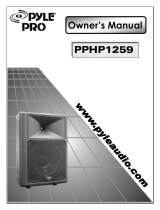
13
3 Hookup
3.1 Rear-Panel Connections and Controls
StudioLive
™
AI-Series Loudspeaker
Owner’s Manual
Speaker Level. This control attenuates the output level of your StudioLive full-range
loudspeaker’s internal amplier. As with the Line Input level control, in most
situations, you can set this knob fully clockwise to the 0 dB setting.
Note: The Mix output level is not aected by the Speaker level control.
Power User Tip: The Speaker level control allows you to set the maximum
output level of your speaker. This is especially useful in situations where there
is an SPL ordinance in eect or where your audience and your front-of-house
engineer have dierent opinions about how loud a performance should be.
DSP Contours. Your StudioLive AI-series loudspeaker is equipped with three DSP
contour presets. These contours change the character of your StudioLive loudspeaker
in a fundamental way, adjusting FIR lters, alignment, and crossover settings to
customize your loudspeaker for one of three applications:
• Normal. Normal mode sets dynamics and equalization for optimum
performance for live music. This mode is suitable for use with
PreSonus StudioLive consoles and most other mixing consoles.
• LBR Source. AI-series loudspeakers are designed to provide high-resolution,
accurate reproduction of high-quality recordings and live mixes. When low-
bit-rate MP3s are played, the unusual clarity of AI speakers may reveal the
artifacts of MP3 compression to an unattering degree. The LBR Source
contour is specically designed to reduce the audibility of these artifacts.
• Floor Monitor. Floor mode sets dynamics and equalization for
optimum results when the loudspeaker is used as a oor monitor.
Because these contours are changing fundamental tuning parameters,
your StudioLive AI-series loudspeaker will mute momentarily while the
new parameters load. Because of this, do not change the DSP contour
once your performance has begun. Press the recessed button below
the User LED repeatedly to step through the three contours.
User Layer. The User Layer accesses DSP settings that you create using SL Room
Control software. This layer contains custom EQ, High Pass Filter, Delay, and Group
settings. Parameter adjustments in SL Room Control are automatically stored in the
DSP memory in real-time. You can also create and load user presets from SL Room
Control. For more information on SL Room Control, see the SL Room Control
Reference Manual. Press and hold the recessed button below the User LED to turn
the User Layer on or o. This will apply the User Layer parameters on top of the
currently selected DSP contour when you are not connected to SL Room Control.
100 Hz High Pass Filter. This option engages a highpass lter that removes
frequency content below 100 Hz. Engaging the highpass lter will also adjust phase
and time-alignment settings. Because of this, your loudspeaker will mute
momentarily while these new internal settings are being applied. While these
settings are optimized for use with the StudioLive 18sAI, you can use this mode with
any subwoofer to remove unwanted low-frequency content.
Power User Tip: The three full-range loudspeakers are phase and time-aligned to
form a true 4-way system when paired with an 18sAI subwoofer, with or without the
100 Hz High Pass Filter engaged. With most 4-way systems, leaving frequency content
below 100 Hz in the full-range loudspeaker can introduce destructive cancellations
with the highest frequencies that are reproduced by the subwoofer. StudioLive AI-series
loudspeakers are designed to avoid this problem when combined with an 18sAI
subwoofer. This means that for applications where a frequency overlap at 100 Hz is
benecial, you can achieve bigger bass sound without any extra eort. For applications
that require a more linear frequency response between the subwoofer and full-range
content, simply engage the highpass lter on the full-range AI-series loudspeaker.
This will also readjust the phase and time-alignment to keep it in phase with the 18sAI
subwoofer, enabling you to create the best four-way system for your application.
























